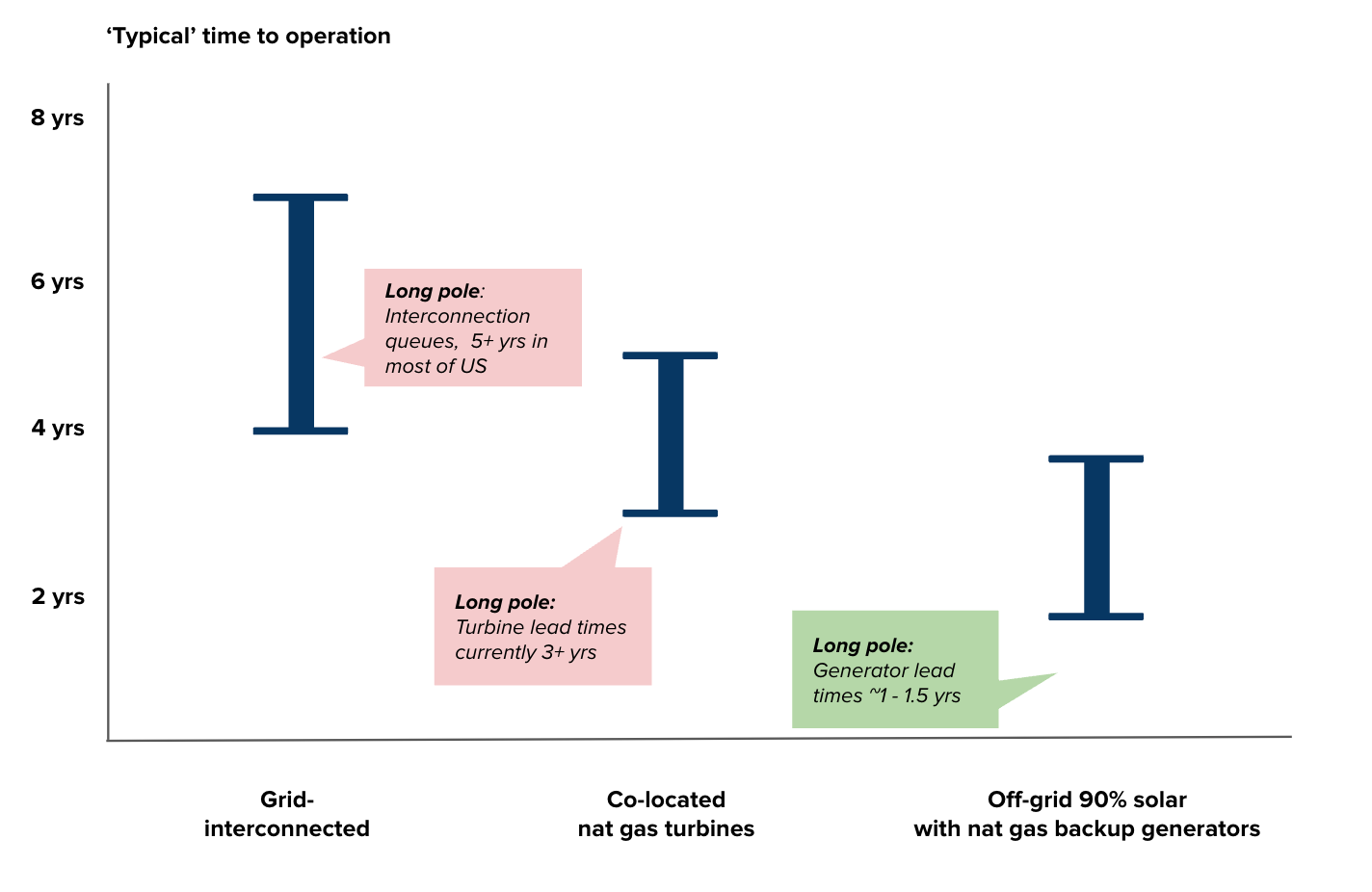Fast, scalable, clean, and cheap enough
How off-grid solar microgrids can power the AI race
Here’s something I helped write alongside the wonderful teams at Stripe and Paces. The summary and key findings are shown below, but if you want to read it in its original form and download the open source data and calcs, I encourage you to check out the full whitepaper here!
Context
Hyperscalers need enormous amounts of power ASAP to power AI datacenters. While highly speculative, estimates range from ~30-300 GW by ~2030.
Speed is paramount. Procuring huge amounts of energy fast is a strategic imperative for hyperscalers and is of national security importance as well.
Grid expansion today in the US is slow. While emerging clean firm generation technologies may promise eventual integration with datacenters, these technologies are unlikely to scale fast enough to meet enormous near-term datacenter energy needs. Many believe the AI needs in the US will most likely be met by building colocated natural gas power plants.
While climate is not the top priority of hyperscalers today, building more natural gas would further increase emissions, which the US is trying to reduce. It would be preferable if we could find ways to build more energy without emitting more, without sacrificing speed or meaningfully increasing cost.
Key questions
Could off-grid solar microgrids in the US be big enough, fast enough, and cheap enough to be a compelling near-term alternative to building more natural gas power plants to meet near-term AI energy needs?
If yes, what would that look like and how would one do it?
What we did
Scale Microgrids ran 20-year powerflow models for thousands of site configurations supporting a 100-1000 MW 24/7 load and ran them them all through Lazard's LCOE model¹ to find the best performers. Paces then did a search for all the land in the US Southwest that could accommodate them (filtering for things like distance from natural gas pipelines, property owner type, minimum parcel size, etc.).
Download the full LCOE workbook developed by Scale Microgrids to play with assumptions.
Key findings
Off-grid solar microgrids are categorically faster than new grid interconnections (5+year queues) as well as off-grid colocated gas turbines (3+ year lead times).
Estimated time to operation for a large off-grid solar microgrid could be around 2 years (1-2 years for site acquisition and permitting plus 1-2 years for site buildout), though there’s no obvious reason why this couldn’t be done faster by very motivated and competent builders.
While solar scenarios modeled in this paper also include 125% capacity of gas engines, these are easier to acquire and faster to build than large dedicated, always-on gas turbines.
Rental generators—such as those being used by XAI prior to getting a grid connection—are potentially the fastest ‘absolute’ path to power but their limited availability would be quickly exhausted by large-scale adoption (in addition to their high costs at >$300/Mwh). These can be utilized before a final project is commissioned for either off-grid solar microgrids or colocated gas turbine approaches.
Off-grid solar microgrids today are near cost parity with natural gas and cheaper than other clean alternatives. Opportunities for further cost reduction are significant.
A microgrid that supplies 44% of lifetime demand from solar and includes 125% natural gas backup is approximately the same cost as using large off-grid natural gas turbines ($93/MWh versus $86/MWh).
A system supplying 90% of lifetime demand from solar is cheaper than repowering Three Mile Island ($109/MWh versus $130/MWh).
Further power system design optimization enabled by off-grid solar could reduce cost by another 10%+.
Off-grid solar microgrids are enormously scalable, with >1,200 GW of datacenter potential in the US southwest alone.
This is enough suitable land to cover ~4-40X all of the datacenter growth projected in the US through 2030 (~30 to 300 GW of new development by 2030).
The vast majority of this is in West Texas, which is mostly a function of gas pipeline density (if you relax this constraint by using diesel backup generators instead, you can build almost anywhere with good sun). And, >95% of the land is private, making it commercially viable today.
Paces has a database of exact parcels that meet these criteria with contact information for landowners. Further design optimizations could further reduce land requirements by ~25%.
Between 0.4 billion tons (30 GW new datacenters) and 4.1 billion tons (300 GW new datacenters) of CO₂ emissions could be avoided between now and 2030 if every new AI datacenter was built using the 90% solar configuration. At approximately $50/ton CO₂ reduced, replacing gas-powered datacenters with off-grid solar microgrids represents a cost-effective emissions mitigation strategy.




